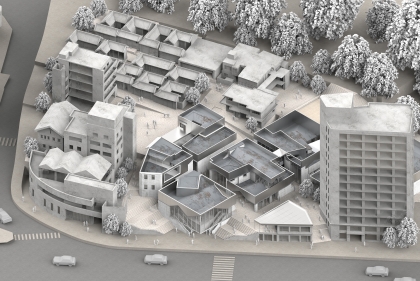September 25, 2025
Culture, Commerce and Other Dimensions of the City at Night
By Jared Brey
Close
Leni Schwendinger (center) and Michael Fichman (right) lead the tour.
“A relative lack of lighting and activation makes this sort of an eerie and desolate place,” Fichman says. “Here we were talking about the different levels of comfort among different members of the class about whether this would be a path that they would like to walk down, even if it was the shortest one. We were gauging our feelings of comfort with the lighting environment.”
“Here we were looking at the relative amount of illumination on the crosswalks in a high-speed arterial corridor, thinking about how illumination influences safety in a different way. This is not about interpersonal safety. This is about the safety of the transportation environment … There’s a public/private lighting initiative, Nighttime Design, that is geared toward safety, comfort, and walkability for a different public than the city is legally mandated to care for.”
In years past, businesses along the 3400 block of Sansom Street had entrances on Moravian Ct., a small alley between Walnut and Sansom. “At times this was an extremely open and inclusive social space where people programmed it a lot with music and art and entertainment,” Fichman says. “Fifteen or 20 years ago, there were internationally famous DJs playing in this alley. You see that there’s some vestige of that with this really nice lighting but it’s also being sort of neglected as a little bit of a loading zone ... It used to be the front door and now it’s the back door. It used to be an extremely social space with eyes on the street and a feeling of safety and a cultural offer for students and people who lived in the neighborhood. And now that’s very closed off. ... To what degree does that have to do with the public-private ownership of this space? To what degree is the sociality of it dictated by individual choices in design by the business owners?”
“Leni is formerly a theatrical lighting designer who, like many people who gravitated towards this intersection of planning, policy, and cities at night, comes from the arts community,” Fichman says. Schwendinger’s NightSeeing™ tours help city officials and business district leaders understand how lighting schemes can promote urban vitality, and the approach helps students understand how city spaces function at night. “Having Leni there to flip your interpretation of an urban streetscape on its head was necessary to giving our students the interpretive lens to do their field observations this semester,” Fichman says.
“Who uses the city at night and what do they need? Some people are going out and enjoying arts and hospitality and leisure, but other people are going to and from work,” Fichman says. “One of the problems of trying to govern a nighttime city in an effective way is that services like transportation require scale to function correctly, from a financial perspective. Nighttime just does not offer the scale, but there's still an enormous amount of need. A photo like this makes me think about the life of somebody who is coming to work at Penn, or a nearby restaurant or hospital, and what their needs are.”


 View Slideshow
View Slideshow


